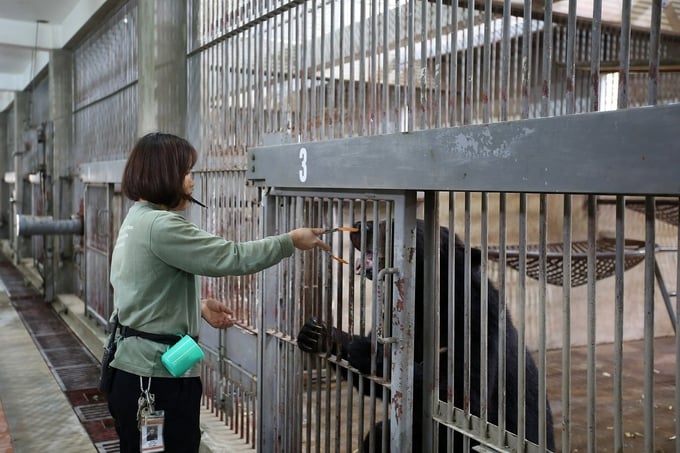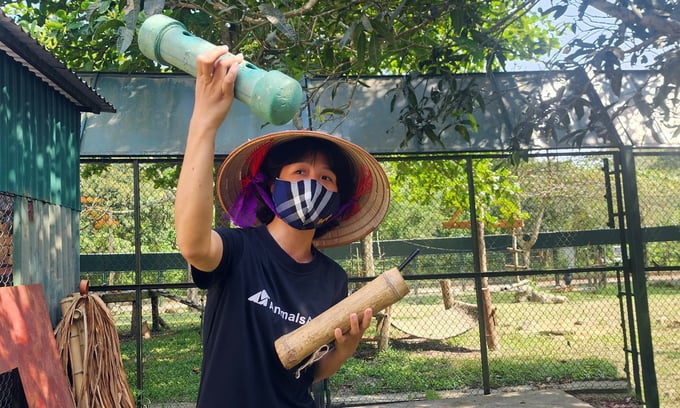May 31, 2025 | 23:48 GMT +7
May 31, 2025 | 23:48 GMT +7
Hotline: 0913.378.918
May 31, 2025 | 23:48 GMT +7
Hotline: 0913.378.918

Center staff are taking care of bears in the semi-wild area. Photo: AAF.
It is early autumn, but the sun has not yet set in Tam Dao National Park. In the sometimes dense atmosphere, sometimes reaching more than 36 degrees Celsius, a few blackheads popped out. They gazed absentmindedly towards the verdant grass, where the Vietnam Bear Rescue Center employees were engaged in their work. One secreted the food on the ground, while the other ascended the ladder and tucked small portions of fruit into a concealed crevice on the tree trunk.
Do Thu Hang, the education manager at the center, explained to the puzzled visitors that efforts are being made to restore the bears' senses. Before returning to the center, the majority of bears have been in long-term captivity. They must be retrained because they have been "deprived of" natural instincts such as smelling and locating prey.
For a more efficient training program, the menu for bears alters daily and never repeats within a week. In addition to vegetables, fruits, and honey, the personnel at the center also prepares yogurt, jelly, delectable sweets, and ice cream. These foods are initially unpackaged, and as the difficulty increases, they are concealed beneath plastic tubing, bamboo tubes, or submerged in streams. Some bears with limited mobility require stimulation for muscle development. They must frequently locate food in rock crevices or high tree limbs, which exercises their strength and stimulates their senses of scent and sight.
After circling the bear's home, Ms. Hang led us into the kitchen and open the large refrigerator. Two frozen slabs are set in a plastic bowl containing numerous sparkling areas. Simply inquire, this stone block contains jelly, a favored dish of bears on sweltering days. To savor the gelatin, however, the bear must pass a brief IQ test. Normally, they would be anxious to shatter the dense layer of rock, but only healthy individuals are capable of doing so. Most must choose an alternate path.
"I once saw a bear toss this entire boulder into the lake. Then, they will submerge there to reduce their body temperature while waiting for the ice to thaw, after which they will consume a piece of ice jelly," said Hang.

Bears at the Vietnam Bear Rescue Center, located in Tam Dao National Park. Photo: Tung Dinh.
In an area larger than 10 hectares, these bear training materials are abundant in the bear sanctuary. A few large tires cling to a wooden bridge that was as tall as an adult's waist in one location. To strengthen the bear's arm musculature, the sisters in the kitchen once proposed constructing a rockery for the bear to practice climbing. Looking at the assortment of tools prepared by the Vietnam Bear Rescue Center staff, we imagine that they are constructing a resort for four-legged visitors at an altitude of 1,000 meters. There, bears can play, exercise, unwind, and rediscover their zest for life.
Hang brought us back to reality by wafting in front of her eyes a small pestle-shaped wooden object with a relatively large opening in the center. According to her, this is the bears' favorite activity at the center, particularly for those reverting to semi-wild status. The center's staff will place food in the apparatus and allow the bear to forage naturally. One reached inside to retrieve the food, while the other laid on his back to empty it directly into my mouth. A few impatient individuals will hurl the object or use crushing force to obtain sustenance.
In order to make the necessary adjustments, the center's staff meticulously documents each bear exercise and training method. For instance, if a bear is lethargic or avoids meals frequently, veterinarians will be contacted. Or, if bears are so preoccupied with a play that they disregard the mealtime chime, they will be attentively monitored for several weeks. If necessary, relocate the bear and give him the opportunity to make new companions.
Vietnam Bear Rescue Center has constructed facility 2 in Bach Ma National Park in response to the growing demand for bear rescue. This is a facility approved by the Ministry of Agriculture and Rural Development and supported by a grant from Animals Asia totaling more than ten million dollars.
More than 12 hectares in size, the center will rescue and care for approximately 300 bears rescued from private breeding facilities and illegal activities. It is anticipated that the first bears will be relocated in August of this year.
Few people realize how much suffering the bears at the Vietnam Bear Rescue Center have endured in the past when they see them thriving in tens of thousands of square meters of space.
Do Thu Hang informed us of a bear whose name was Grier. Before returning to Tam Dao, he had become blind in both eyes and could no longer subsist in the environment. Therefore, Grier inked a lifetime care agreement with the center.
When this sun bear first returned to the center, officials and employees encountered numerous obstacles. According to Hang, Grier lives in seclusion and is almost terrified of all outside influences. "We know from experience that bears are terrified by the sound of metal colliding. "Some people are even afraid of light," she stated.

Food will be hidden in bamboo and plastic pipes like this to wake up the bear's instinct. Photo: Tung Dinh.
The center's personnel had to gradually become accustomed to and overcome their dread of bears. Throughout the procedure, they must periodically monitor the bear's weight, blood pressure, and dietary intake. When the bear is deemed "brave" and no longer exhibits signs of anxiety, such as standing and swaying his entire body for hours on end, he will be returned to the semi-wild area.
In the case of Grier, this individual was already seeking sustenance in wooden posts, trees, and toys after a few months. It is no longer lonely and can play with new companions in the common home with confidence.
Chu Bich Ngoc, an employee at the facility, noted that the majority of bears rescued at Tam Dao were raised for the sale of bile. All techniques must be invasive, inflicting discomfort and injury on the bears. This also leads to infection and the formation of lesions in the gallbladder, liver, and kidneys.
Working at the center for five or six years, Ngoc recalls that the number of healthy people she has interacted with is quite limited. Also, for this reason, the lifespan of bears is significantly reduced.
In addition to caring for bears, the facility designates a hillside as a cemetery for bears. There are approximately fifty people buried here as of July 2023; they perished of old age or incurable diseases. In the presence of all local staff, authorities, and rangers, each deceased bear will be grieved, a poem about bears will be read, and the bear will be buried with food and items that it enjoyed while it was alive.
Translated by Linh Linh
/2025/05/29/5625-12-214801_567.jpg)
(VAN) Provincial mergers in the Mekong Delta promise to streamline administration, expand inter-provincial raw material areas, and foster close linkages in agricultural value chains, benefiting both businesses and cooperatives.

(VAN) Merging Mekong Delta provinces contributes to the expansion of agricultural raw material areas, addressing previous constraints caused by provincial boundaries. Additionally, this expansion will reduce costs and strengthen linkages between businesses, cooperatives, and farmers.
/2025/05/29/1043-2-153730_145.jpg)
(VAN) The Government's policy to merge provincial-level administrative units opens up major opportunities for the Mekong Delta region to reshape its agricultural development strategy toward large-scale production, effective regional linkages, and sustainability.

(VAN) The mutual export of agrifood products between the European Union (EU) and the United Kingdom (UK) must occur again without certification, border controls or other red tape. This was agreed at the UK-EU summit.
/2025/05/22/5121-2-173645_677.jpg)
(VAN) NBSAP Tracker identifies strengths and areas for improvement in the National Biodiversity Strategy, based on each region’s priorities and capacities.

(VAN) The draft amendment to the Circular on rice export trading stipulates a periodic reporting regime for rice exporting enterprises.

(VAN) Dong Thap farmers attained an average profit margin of 64% during the summer-autumn 2024 crop (first season), while An Giang and Kien Giang farmers followed with 56% and 54%, respectively.